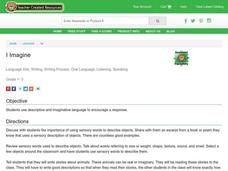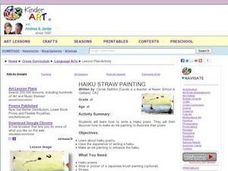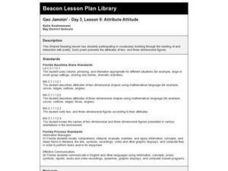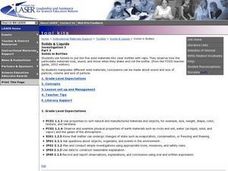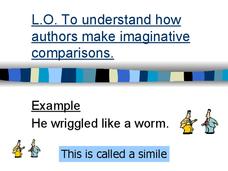Curated OER
Double Exposed Photographs
Students create double-exposed photographs, poetry, and multimedia presentations. In this artwork lesson plan, students explore cameras, poems, and other art forms to understand line, light, and other attributes that contribute to artwork.
Curated OER
Ode to a Nightingale
High schoolers read poems about Tuberculosis by John Keats. Using the poems, they identify similies, metaphors, personification and imagery. In groups, they make connections about the author's outlook on life and how his disease...
Curated OER
Character Education: Caring
Learners create a bookmark with reminders of simple acts of kindness. In this character education lesson, students participate in a mini-lesson that serves as a great introduction to a service project. Learners first brainstorm ways to...
Curated OER
Visual and Number Patterns
Fourth graders develop strategies for identifying geometric and number patterns. In this mathematical patterns lesson plan, 4th graders use pattern blocks to make repeating patterns with numbers and shapes. Students then explore number...
Curated OER
Senior Scrapbook Assignment
Twelfth graders write creatively and reflectively on 20 different events or memories that shaped their senior year. They organize memorabilia into a scrapbook with 20 entries and create a cover that represents their senior year. They...
Curated OER
I Imagine
Students discuss the importance of using sensory words to describe objects; talking about words that refer to size, shape, texture, sound, smell, etc. They select a few objects around the classroom and use sensory words to describe.
Curated OER
Where Does the Green Go?
Students investigate why green leaves change colors in the fall. They press leaves and write a poem, create a chlorophyll leaf print, take a nature walk, and create a leaf shape poster.
Curated OER
Bridges:Links to History
Seventh graders perform a research project based upon the study of the types of bridges. After preliminary research, student groups will search for four examples of each type located around the world.
Curated OER
Trait Variations for Survival
Young learners examine how different traits could give one organism an advantage over another. In groups, they view two different organisms in different environments. To end the lesson plan, they complete a Venn Diagram on the two...
Curated OER
Geo Jammin' - Day 6, Lesson 20: Hail, Hail, the Gang's All Here
Students use shape puppets to review geometry content. They take turns singing songs, reading students poems, reciting class bulletin board notes and choral poems. They prepare for their summative assessments through play and interview...
Curated OER
Haiku Straw Painting
Students explore haiku poetry, have the experience of writing a haiku, and make an ink painting to enhance the haiku.
Curated OER
Geo Jammin' - Day 3, Lesson 9: Attribute Attitude
Second graders read poetry and build their vocabulary through use of the puppet Geo George.
Curated OER
Nevermore
Students research and record on a timeline the biography of a chosen poet correlating the poetry of the bard with those events which shaped his or her life. The events of the poet's life are examined to contrive meaning of the writings...
Curated OER
Geo Jammin' By DeSign - Day 1, Lesson 5: Do You Hear What I Hear?
Students listen to a poem that includes directions to use geometric figures to complete a creative task.
Curated OER
Art and Literacy, grades 3-6, Reading Comprehension Category: Critical Stance
Students compare two very different works of art and two poems, and verbally list similarities and differences they perceive in the works of art and the poems; students then select poem that best correlates with a work of art.
Curated OER
Solids in Bottles
Learners use funnels to put the five solid materials into clear bottles with caps. They observe how the particulate materials look, sound, and move when they shake and roll the bottle. Finally, students write "sound and touch" poetry.
Curated OER
Blooming Up: Teaching the Art of Questioning
Students, through demonstration and example, write and answer questions at different levels of Bloom's taxonomy.
Curated OER
Geography: I Spy Environments
Fourth graders examine nature paintings from a Utah museum for their physical characteristics. In small groups, they observe museum postcards and discuss the season, precipitation, temperature, and geometric shapes pictured. Focusing...
University of Arizona
Fusing Firecrackers with Narrative
Improve your youngsters' descriptive writing. They study an object and write about what they see as a warm-up, then they read an excerpt from Paul Guest's memoir, One More Theory about Happiness. The next part of the...
Curated OER
The Cinquain
Students explore writing a cinquain. Students engage in a pantomime experience. They observe and describe bubbles. Students compose a cinquain and illustrate their work with bubble art.
Curated OER
Synonyms
Similes and Synonyms are the focus of this language arts presentation. After being introduced to similes and how they work, young writers practice writing similes about the sun by using phrases such as, "The sun is like a golden ring...
Lisa Staab Shadburn
Play Therapy Activities to Enhance Self‐Esteem
Discover activities to help learners increase self-awareness, build peer and family relations, and develop positive self-esteem. Here you'll find six suggestions for instilling a sense of confidence and self awareness in youngsters. Each...
Curated OER
Fall Similes
Students create descriptive autumn similes and write them on fall-themed paper. They first write the autumn simile, and then arrange the plants around the border of the paper. They use natural plants which must be pressed.
Curated OER
Spiral Breeze Catcher
Third graders participate in a creative project in order to investigate how a tornado moves. The use of a spiral catcher is used to model the movement of a tornado. Students also watch "The Wizard of Oz" to create context for the lesson.







